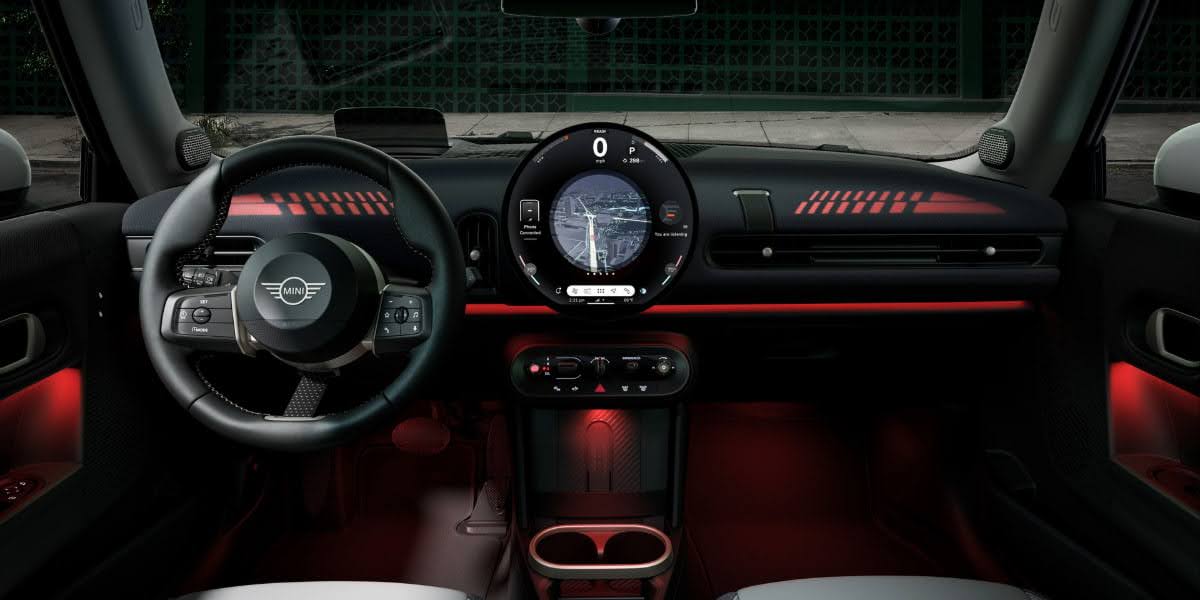Taking care of your car doesn’t have to be complicated. Two of the most important things you can do are knowing when to replace car battery parts and staying on top of your Mini oil change schedule. Whether you drive a Mini Cooper or just want to learn about car maintenance, this guide will help you keep your car running great for years.
What You Need to Know About Car Batteries Today
Car batteries have gotten much better in recent years. The car battery business is expected to hit $112.42 billion in 2025 and keep growing fast. This growth comes from better technology in both regular car batteries and new types being developed.
Most cars, including Mini Coopers, still use lead-acid batteries. These batteries have been around for about 150 years, but they’re much better now than they used to be. Car makers have made them last longer and work better in all kinds of weather.
Two newer types of batteries are becoming popular: Enhanced Flooded Batteries (EFB) and Absorbent Glass Mat (AGM) batteries. These work better than regular batteries and last longer. They’re especially good for cars that automatically turn off and on at red lights to save gas.
How to Tell When Your Battery Needs to Go
Knowing when to replace car battery parts can save you from getting stuck somewhere with a dead car. Most car batteries last about three years, but a few things can make them die sooner or last longer.
Weather makes a big difference. Really hot or really cold weather is hard on batteries. If you mostly take short trips that don’t give your car’s charging system time to fill up the battery, it won’t last as long.
Signs Your Battery is Getting Weak
Watch for these warning signs that mean it’s time to replace car battery parts:
- Your car starts slowly, especially when it’s cold outside
- Warning lights show up on your dashboard
- You see white, crusty stuff on the battery terminals
- Your battery is more than three years old
- Your headlights seem dim or other electrical things don’t work right
Consumer Reports tests over 100 car batteries every year in tough conditions that copy real driving. Their tests show that spending a little more on a good battery is usually worth it.
For a complete breakdown of Mini Cooper battery specs and replacement schedules, check out our detailed Mini Cooper battery longevity guide to learn more about what makes Mini batteries unique.
How to Replace Your Car Battery Yourself
What You’ll Need
Before you try to replace car battery parts, get these tools ready:
- A set of wrenches (usually 10mm or 8mm)
- Safety glasses and work gloves
- A wire brush to clean terminals
- Spray to protect battery terminals
- A tool to test electrical stuff (multimeter)
Safety comes first. Always work where there’s good air flow and don’t smoke or make sparks near the battery.
Replacing Your Battery Step by Step
Getting Ready
Make sure your car is parked on flat ground and the engine is completely cool. Find your battery – in most Mini Coopers, it’s under the hood, but some models have it in the trunk or under a seat.
Turn off your car and take out the keys. Look for the positive and negative terminals. The positive one usually has a red cover or plus sign, and the negative one is black with a minus sign.
Taking Out the Old Battery
Always take off the negative terminal first – this keeps you from accidentally causing a short circuit. Use your wrench to loosen the clamp and carefully pull it off the battery post. Do the same thing with the positive terminal.
Remove any brackets or clamps that hold the battery in place. Carefully lift the old battery straight up. Batteries are heavy (about 40-60 pounds), so lift with your legs, not your back.
Putting in the New Battery
Before you put in the new battery, clean the terminal clamps and the battery area with your wire brush to get rid of any white, crusty buildup. Put the new battery in place and make sure it sits flat and secure.
Connect the positive terminal first, then the negative one. Tighten the clamps so they’re snug but don’t over-tighten them – you could damage the terminals. Spray the terminals with protectant to stop future corrosion.
What’s New with Batteries in 2025
Battery technology keeps getting better. Scientists are working on solid-state batteries that use solid materials instead of liquids. These are safer and can store more energy. Right now, they’re mainly for electric cars, but they might be used in regular cars someday.
Electric car battery prices are dropping fast – they’re expected to cost almost 50% less by 2026. As companies make more batteries and get better at it, regular car batteries might get cheaper and better too.
Understanding Your Mini’s Oil Needs
Keeping up with your Mini oil change schedule is super important for keeping your engine running well. Modern Mini Coopers have smart computers that watch your oil and tell you when it’s time for service based on how you actually drive, not just how many miles you’ve gone.
When you buy a new Mini Cooper, you get free maintenance for the first three years or 36,000 miles. This includes oil changes and other routine care, which saves you money while your car is new.
Different driving styles impact both your oil change schedule and fuel efficiency – learn more about how MPG works in your Mini Cooper and how proper maintenance improves both performance and gas mileage.
When to Change Your Mini’s Oil
Most Mini vehicles need an oil change about every 8,000 to 10,000 miles or once a year, whichever comes first. But how you drive makes a big difference in these timing.
Your Mini has something called a Condition Based Service (CBS) system that automatically watches your oil and shows warnings on your dashboard when you need service. This smart system looks at things like:
- How hot and cold your engine gets
- How often you start your car when it’s cold
- How fast you drive and how hard you work your engine
- What kind of weather and roads you drive in
Things That Mean You Need Oil Changes More Often
Some types of driving mean you need Mini oil change services more often:
- Lots of short trips (less than 10 miles)
- Stop-and-go city driving
- Really hot or cold weather
- Dusty or dirty roads
- Pulling trailers or carrying heavy stuff
- Track days or spirited driving
If you do a lot of this kind of driving, all MINI vehicles should receive an oil change every 4,000 to 6,000 miles instead of the usual schedule.
What Kind of Oil Your Mini Needs
Choosing the right oil for your Mini Cooper is one of the most important decisions you’ll make for your car’s health. Modern Mini Coopers aren’t just regular cars – they’re high-performance machines with engines that work harder and get hotter than most vehicles. That’s why they need special oil that can handle the extra stress.
Understanding Oil Numbers and What They Mean
When you see numbers like 0W-20 or 5W-30 on oil containers, those numbers tell you how thick the oil is at different temperatures. The first number (with the W) shows how the oil flows when it’s cold – like when you start your car on a winter morning. The second number shows how thick the oil stays when your engine gets hot.
Lower numbers mean thinner oil that flows easier:
- 0W flows better in freezing weather than 5W
- 20 weight oil is thinner when hot than 30 weight oil
- Thinner oil helps your engine start easier and saves gas
- Thicker oil protects better under extreme heat and stress
Why Mini Engines Need Special Oil
Mini Cooper engines are built for performance. They’re small but powerful, which means they work harder than most engines. Here’s why regular oil just won’t cut it:
High-performance engines create more heat: Your Mini’s engine runs hotter than a regular car engine, especially if you like to drive spiritedly. Regular oil breaks down faster under this heat.
Precision engineering needs precision lubrication: Mini engines have tight tolerances between moving parts. The wrong oil can cause extra wear or even damage.
Turbo engines need extra protection: Many Minis have turbochargers that spin incredibly fast and get extremely hot. They need oil that won’t break down under these extreme conditions.
Full Synthetic vs. Other Oil Types
Your Mini needs full-synthetic oil, but what does that really mean? Here’s the breakdown:
Conventional Oil
- Made from crude oil pulled from the ground
- Works fine for basic engines
- Breaks down faster under heat and stress
- Cheaper upfront but needs changing more often
- Not recommended for any Mini Cooper
Synthetic Blend
- Mix of conventional and synthetic oil
- Better than conventional but not as good as full synthetic
- Still not right for your Mini’s needs
- Might save money initially but could cost more long-term
Full Synthetic Oil
- Engineered in laboratories for specific performance
- Stays cleaner longer and protects better
- Handles extreme temperatures without breaking down
- Costs more upfront but lasts longer
- The only type recommended for Mini Coopers
Oil Requirements by Mini Generation
Different generations of Mini Coopers have different oil needs. Using the wrong oil can hurt your engine’s performance and even void your warranty. Here’s what each generation needs:
Gen 1 Minis (2002-2006): The Originals
These are the first modern Minis that brought the brand back to life. If you have one of these classic Minis, here’s what you need to know:
Models included:
- R50 Hardtop/Hatchback MINI Cooper
- R53 Hardtop/Hatchback MINI Cooper S
- R52 Convertible MINI Cooper (both regular and S)
Oil specification: SAE 5W-30 full synthetic
Why 5W-30: These engines were designed when oil technology was different. The 5W-30 provides the right balance of protection and flow for these older designs.
Common questions about Gen 1 oil:
Q: Can I use 0W-30 instead of 5W-30 in my older Mini? A: While 0W-30 flows better when cold, stick with 5W-30. These engines were designed and tested with 5W-30, and changing could affect seals and gaskets.
Q: How much oil does my Gen 1 Mini hold? A: Most Gen 1 Minis take about 4.2 liters (roughly 4.4 quarts) with a filter change.
Q: My Gen 1 Mini has high mileage. Should I use high-mileage oil? A: If your Mini has over 75,000 miles and uses some oil between changes, high-mileage 5W-30 synthetic can help reduce consumption.
Gen 2 Minis (2007-2013): The Refined Generation
The second generation of modern Minis brought more models and improved engines. These Minis have more flexibility in oil choices:
Models included:
- R56 Hardtop/Hatchback MINI Cooper (regular and S)
- R55 Clubman MINI Cooper (regular and S)
- R57 Convertible MINI Cooper (regular and S)
- R58 Coupe MINI Cooper (regular and S)
- R59 Roadster MINI Cooper (regular and S)
- R60 Countryman MINI Cooper (regular and S)
- R61 Paceman MINI Cooper (regular and S)
Oil specifications: SAE 5W-30 or 0W-30 full synthetic
Why the choice: Gen 2 engines can handle both weights. The 0W-30 flows better in cold weather and may provide slightly better fuel economy.
Choosing between 5W-30 and 0W-30:
Use 5W-30 if:
- You live in moderate climates
- You want to stick with BMW’s original recommendation
- You do a lot of highway driving
- Your Mini has higher mileage
Use 0W-30 if:
- You live where winters get below 10°F
- You want maximum cold-weather protection
- You do mostly city driving with lots of cold starts
- You want slightly better fuel economy
Common questions about Gen 2 oil:
Q: Can I switch between 5W-30 and 0W-30? A: Yes, you can switch between these weights at any oil change. Both meet your engine’s needs.
Q: What’s the oil capacity for Gen 2 Minis? A: Most Gen 2 engines hold 4.25 to 4.5 liters (about 4.5 to 4.75 quarts) with filter replacement.
Q: My R56 has the N14 engine. Does it need special care? A: The N14 engine (2007-2010 Cooper S) can be sensitive to oil quality. Always use top-quality synthetic and consider slightly shorter change intervals.
Gen 3 Minis (2014 and up): The Modern Era
The newest generation of Minis represents the latest in engine technology. These engines are designed for maximum efficiency and performance:
Models included:
- F56 Hardtop/Hatchback MINI Cooper (regular and S)
- F55 Hardtop/Hatchback 4-Door MINI Cooper (regular and S)
- F57 Convertible MINI Cooper (regular and S)
- F54 Clubman MINI Cooper (regular and S)
- F60 Countryman MINI Cooper (regular and S)
Oil specification: SAE 0W-20 full synthetic
Why 0W-20: These modern engines have tighter tolerances and are designed for maximum fuel efficiency. The thinner 0W-20 oil reduces friction and improves gas mileage while still providing excellent protection.
Important notes for Gen 3 owners:
Stick with 0W-20: Don’t be tempted to use thicker oil, thinking it provides better protection. These engines are designed specifically for 0W-20.
Quality matters more than ever: Gen 3 engines have very tight clearances. Using cheap oil or extending change intervals can cause serious problems.
Turbo engines need extra attention: If you have a Cooper S with a turbo, that turbocharger depends on clean oil for cooling and lubrication.
Common questions about Gen 3 oil:
Q: Can I use 5W-30 in my newer Mini if I can’t find 0W-20? A: In an emergency, you can use 5W-30 temporarily, but change to 0W-20 as soon as possible. Thicker oil can hurt fuel economy and potentially cause issues.
Q: How much oil does my Gen 3 Mini need? A: Gen 3 engines typically hold 4.2 to 5.45 liters, depending on the specific engine. Check your owner’s manual for exact capacity.
Q: Why does my new Mini use 0W-20 when older ones used thicker oil? A: Modern engines are built with much tighter tolerances and better materials. The thinner oil actually provides better protection while improving fuel economy.
Understanding Oil Brands and Quality Levels
Not all synthetic oils are created equal. Here’s what to look for when choosing oil for your Mini oil change:
BMW Approved Oils
BMW (Mini’s parent company) has specific oil approvals:
- LL-01: For most gasoline engines
- LL-04: For engines with particulate filters
- Look for these codes on oil containers
Quality Oil Brands for Minis
Premium options:
- Castrol GTX High Mileage (for older Minis)
- Mobil 1 European Car Formula
- Liqui Moly Special Tec AA (Mini-specific)
- BMW/Mini branded oil from dealers
Good mainstream options:
- Castrol GTX Magnatec
- Valvoline MaxLife (for high-mileage)
- Shell Helix Ultra
- Mobil 1 Annual Protection
Special Considerations for Different Driving Styles
How you drive affects what oil might work best for your Mini:
Track Day Warriors
If you take your Mini to the track:
- Stick strictly to factory specifications
- Consider slightly more frequent changes (every 5,000 miles)
- Let the engine cool completely before checking oil level
- Monitor oil consumption more closely
City Commuters
For stop-and-go city driving:
- 0W oils help with frequent cold starts
- Consider more frequent changes due to short trips
- Monitor oil level monthly due to harder working conditions
Highway Cruisers
For mostly highway driving:
- Factory specifications work perfectly
- You might get a longer life from your oil
- Still stick to the recommended change intervals
Money-Saving Tips for Oil Changes
Quality oil is important, but you don’t have to break the bank:
Buy in bulk: If you change your own oil, buying 5-quart containers costs less per quart than individual bottles.
Watch for sales: Auto parts stores regularly have sales on premium synthetic oils.
Consider oil change packages: Many Mini dealers offer prepaid oil change packages that reduce per-service costs.
Don’t go cheap on filters: A quality oil filter is just as important as quality oil.
Red Flags: Oils to Avoid
Some oils can actually hurt your Mini’s engine:
Conventional (non-synthetic) oils: These break down too quickly for high-performance engines.
Wrong viscosity: Using 10W-40 in a Mini designed for 0W-20 can cause problems.
Off-brand synthetics: Some cheap “synthetic” oils don’t meet the quality standards your Mini needs.
Old oil: Oil sitting on store shelves for years can degrade. Check dates when possible.
What Happens If You Use the Wrong Oil
Using incorrect oil in your Mini can cause several problems:
Short-term issues:
- Reduced fuel economy
- Harder cold-weather starting
- Increased engine noise
- Poor performance
Long-term problems:
- Increased engine wear
- Seal and gasket damage
- Turbocharger problems (on S models)
- Voided warranty claims
- Expensive engine repairs
The good news is that using the right oil prevents all these problems and keeps your Mini running like the precision machine it was designed to be.
Getting Your Mini’s Oil Changed
Doing It Yourself vs. Going to a Shop
After your free maintenance period ends, you can expect to spend between $150 and $190 on Mini Cooper oil service when you go to a shop. Mini shops charge about $99.95 for basic oil changes, split pretty evenly between parts and labor costs.
Many Mini owners choose professional service because it takes special tools and knowledge to do it right. Plus, the pros can reset your car’s service computer and check other important stuff while they’re at it.
Understanding what to expect during professional service helps you make informed decisions about Mini Cooper maintenance and service, including which services provide the best value for your investment.
What Happens During a Mini Oil Change
A proper Mini oil change service includes:
- Draining all the old oil and putting in fresh synthetic oil
- Putting in a new oil filter
- Checking all your other fluids
- Looking at belts, hoses, and your battery
- Resetting your service reminder with special computer tools
- Keeping records for your warranty
Your Mini holds about 4.2 to 5.45 liters of oil, depending on what engine you have.
Planning Your Battery and Oil Care Together
Smart car owners plan battery and oil maintenance at the same time. You can often get both things done in one visit, which saves time and might save money too.
Thinking About the Seasons
Winter is tough on both batteries and oil. Cold weather makes batteries weaker and oil thicker, so both systems have to work harder. Getting maintenance done in spring is a great way to check everything after winter’s stress.
Hot summer weather makes oil break down faster and can hurt old batteries. Regular maintenance during nice weather helps get your Mini ready for extreme temperatures.
Making a Maintenance Plan
Create a schedule that works with your Mini’s needs:
- Every month: Look at your battery and check your oil level
- Every three months: Clean battery terminals and double-check fluids
- Twice a year: Professional oil change and battery test
- Once a year: Complete check of electrical system and battery health
Managing Costs and Getting Good Value
Understanding what car maintenance costs helps you decide when to do things yourself versus going to a pro.
Battery Replacement Costs
About 99% of the 100 million car batteries replaced every year get recycled, which helps keep prices reasonable. Good batteries usually cost $100-200, and having someone install it adds about $50-100.
Better batteries often work better in cold weather and last longer, so they’re worth the extra cost even though they cost more up front.
Oil Change Value
The U.S. oil change business was worth about $8.11 billion in 2024 and is expected to keep growing. This growth shows that more people are driving, and cars need more complex care than they used to.
Your Mini oil change is a great deal when you think about how much it would cost to fix your engine if you don’t take care of it. A $150-200 service protects an engine that’s worth tens of thousands of dollars.
New Technology and What’s Coming
Modern cars are getting smarter about telling you when they need maintenance. Mini’s connected services can send reminders right to your phone and even schedule appointments automatically.
Electric cars are starting to use 800V battery systems instead of the old 400V systems, though regular cars still use 12V systems like they always have.
Predicting When You Need Service
New diagnostic tools can predict when you’ll need maintenance before anything breaks. Oil analysis services can tell exactly how much life your oil has left, and battery testers can predict when your battery will die weeks or months ahead of time.
These tools help you plan maintenance at the best times, saving money and preventing breakdowns.
Taking Care of the Environment
Properly getting rid of old car fluids and batteries isn’t just required by law – it’s the right thing to do for the environment. Making car batteries uses a lot of energy and can hurt the environment. Recycling old batteries can save up to 90% of the energy and pollution compared to making new ones.
When you replace car battery parts, make sure the old battery goes to a recycling center. Most auto parts stores and service shops take old batteries and often give you credit toward buying a new one.
Used oil from your Mini oil change has to be recycled properly. Since Americans are driving more than ever for work and fun, properly disposing of oil is more important than ever for protecting the environment.
Fixing Common Problems
Battery Troubles
- Slow starting: Usually means your battery is getting weak or terminals are corroded
- Car won’t start: Could be your battery, starter, or charging system
- Electrical weirdness: Often caused by loose battery connections
Oil Problems
- Oil pressure warnings: Need immediate attention to prevent engine damage
- Using too much oil: Might mean seals or gaskets are worn out
- Dirty oil: Could mean your cooling system or fuel system is leaking
Getting professional help can tell the difference between normal wear and serious problems that need quick fixes.
Ready to Take Great Care of Your Mini?
Learning when to replace car battery parts and keeping up with your Mini oil change schedule are the basics of owning a reliable car. These two important maintenance jobs work together to make sure your Mini Cooper gives you years of dependable, fun driving.
Regular maintenance prevents expensive repairs while keeping your car running well and holding its value. The small amount you spend on routine care pays off big time in reliability, gas mileage, and how long your car lasts.
Whether you just got your first Mini or you’ve been driving them for years, staying on top of these maintenance basics will keep your car running its best. For professional service that really understands what your Mini Cooper needs, contact Braman Mini of Palm Beach to schedule your next maintenance appointment and make sure your car gets the expert care it deserves.






